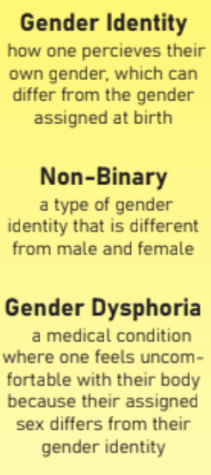Understanding The Identity Spectrum
May 27, 2022
In the LGBTQ+ community, there are many different identities: lesbian, gay, bisexual, transgender — the list goes on. Non-binary is one of those identities, and it, too, includes additional layers. Within the non-binary community, there is a whole spectrum of ways in which people can identify their gender. All of them center around the central idea that gender is not a simple determination of male or female. So what other ways do people define their gender?
One gender identity that can fall within the non-binary spectrum is “agender.” People who identify as agender generally do not feel as though their identity aligns with any gender. Some agender people feel that they have no gender at all; others may not make that determination, but still express themselves as gender-neutral.
Another two non-binary gender identities are bigender and genderfluid. For bigender people, their gender can often be expressed as both male and female; ultimately, being bigender simply means that someone identifies with gender in two different ways. Genderfluidity, while similar, is more indicative of a shift that one person experiences between multiple gender identities. Someone may feel more masculine one day, and wish to express themselves more femininely the next.
“It’s very fluid. I go through months where I’m severely uncomfortable with being seen as feminine, and then there are some months where I feel hyper-feminine,” Hawkins said of their experiences with fluctuations in gender identity.
Hawkins said of their experiences with fluctuations in gender identity.
Additionally, some people identify with male or female gender, but use the prefix “demi-” to indicate that they only partially or sometimes feel that way. These people often identify themselves as non-binary as well.
Ultimately, there are far too many nuances to the spectrum of gender to list every possible term with which someone may identify. Gender identification is a complicated psychological experience, and an even more complex construct within American society. The term “non-binary” serves as an umbrella term that can represent every person who does not align with one binary gender or the other. Additionally, for some people “non-binary” can be an identity in itself, with no further specification needed beyond the fact that their gender does not fit within traditional gender norms.
Goodwin, who described their gender identity as non-binary said, “I kind of just feel like this middle-ground neutral.”